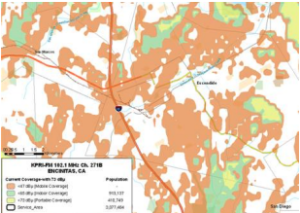MaxxCasting™ A New Concept in FM Boosters

[March 2014] FM stations often run into coverage problems due to transmitter location or terrain issues. Boosters can fill in coverage, but not always successfully. Hal Kneller shares a new solution to make boosters work better.
When and why are boosters needed?
Many think they are only really needed when terrain blockage prevents adequate coverage of a station. This certainly is an appropriate solution. But other cases are equally valid.
For example, there are many “rim-shots” around the US where the transmitter is well outside the desired service area, yet still within the 60 dBu contour, but the signal is compromised by the intensity of more local signals (possible receiver “de-sense”), by a grazing path (lack of Fresnel clearance), or simply attenuated by the distance from the transmitter site to the desired area.
Another use is where a station covers its core market well but there is a secondary area within the protected contour that sales would like to work but the signal is not so competitive.
Problem Areas
KPRI in Encinitas, CA, is a good example of what coverage challenges a station might face. Severe terrain shielding prevents solid coverage in the city of Escondido.

Most of Escondido does not receive solid signal levels from KPRI
Another example deals with a typical “rim-shot” scenario.
WLEY’s transmitter location is about 15 miles outside Chicago. This Aurora, IL station caters 2 to the Hispanic community. And while there is theoretically 1 mV/m coverage over the city, in reality it does not cover. This is largely due to the path profile: poor clearance and a large part of the line of sight being blocked by clutter (buildings).

Both these stations would appear to be able to benefit from booster service – something many FM stations have tried with varying degrees of success.
Boosters
By definition, boosters are on the same frequency as the main station and typically are within the station’s FCC protected contour. They are not allowed, in most cases, to exceed that contour, or to “bump it out.”
The best cases for boosters are the rare instances where there is nearly 100% terrain shielding. Nevertheless, a fair number of stations end up turning them off after they find their systems created more interference zones than the problems they were supposed to fix.
Additionally, failure to synchronize on-channel translators (those outside the main coverage area) also can result in considerable loss of coverage to both the main station as well as the translator.
There is an alternative to standard booster operations: MaxxCasting™ is the name of our patent-pending system. MaxxCasting deviates from the conventional thinking in SFN or boosters by utilizing a number of proprietary technologies.
MaxxCasting
MaxxCasting was developed by the principals of Marathon Media (Chris Devine and Rick Bonick) which, at one time, owned more than 100 stations in small, medium and sometimes major markets – often with secondary facilities or move-ins.
They found themselves needing to improvise to make the signals competitive. The result is a new company, GeoBroadcast Solutions, LLC, to help other broadcasters maximize their facilities.
To add an additional level of confidence in the MaxxCasting technology, it has been validated by NPR Labs and also by listening tests at Towson University to help determine thresholds of acceptable interference levels through focus group testing. (Towson University has provided such services in the past to iBiquity for the HD Radio codec testing as well as for numerous NPR Labs studies.)
Those listening tests assisted in deriving the proprietary formulae utilized in the planning and tuning process.
What Can Be Achieved
Utilizing Maxxcasting, signals can be brought back up to that required for good building penetration and even portable reception.
Perhaps there is severe multipath in an area. MaxxCasting can be used to mitigate that by the addition of one or more synchronous boosters or “nodes” in such locations.
What equipment do we typically use? GatesAir Flexiva transmitters, GatesAir Intraplex IP Link with Synchrocast option and Jampro Java log periodic antennas. The customer has various 3 options with his IP link connectivity between sites and can also use T1 if required.
There are other equipment options if the customer prefers, on a case by case basis.
A Look at the Results
In the KPRI example, a six-node MaxxCast network could be used to cover the market with plenty of signal, improving it from even poor automobile coverage to a city-grade service in most of Escondido.

KPRI would be able to add as many as 28% additional persons to the station’s coverage.
MaxxCasting might help

The multiple synchronized boosters are able to bring signal levels up significantly. The nodes shown highlight possible coverage improvement into the solidly Hispanic portions of the market.
In addition it is possible to micro-target areas within a station’s coverage area.
Sometimes transmitter sites are a substantial distance from targeted areas which results in low field intensity and therefore building penetration problems persist. MaxxCasting designs can be used to improve a station’s signal in specific areas of particularly desirable demographics in areas as small as a zip code.
Learning From the Results
There are a number of things we have learned which make MaxxCasting successful where previous attempts have failed or provided less than the desired outcome. Here are some:
- Use directional antennas (with the signal minima towards the main transmitter)
- Use highly directional antennas, often an “array” is better than one antenna to gain the desired results
- Keep the height of booster antennas low; do not try to cover too much with one booster; use as little power as necessary to cover your booster area
- Use multiple nodes, keep the signal from the booster localized
- Use proper prediction software to examine where the interference will be, how much there will be, and experiment with interference mitigation (we find this modeling to be extremely predictive and accurate – our prediction software, developed over three years, is based on proprietary design models confirmed by NPR Labs and auditorium listening tests.)
- Always place booster transmit antennas inline with the main signal propagation, never across it (see our map models). Going across the signal at more than a few degrees quickly increases simulcast interference (this is why omni-directional booster antennas are never a good idea unless you have virtually complete terrain shielding).
- Acceptable signal levels for interference will vary depending upon mono or stereo requirements
- Terrain can be your friend but it is not always available to block the main signal thus timing and power ratio can help locate interference away from populous areas
- Connection between main transmitter and booster nodes must be stable and reasonably consistent in latency
- New technology now permits the use of compressed audio to feed the boosters (i.e. HE-AAC) greatly reducing through-put requirements in the links
- All exciters and stereo generators in the chain must have identical modulation characteristics; a common audio processsor must feed the main transmitter and all nodes.
MaxxCasting can also be used to synchronize on-channel FM translators located outside the protected contour (providing certain FCC rules are respected).
Successful Signal Improvement
In summary, SFN boosters work extremely well if properly designed networks are implemented.
However, in general, this is not a do-it-yourself project because most people do not have the test gear, computer software or the proprietary design models to do the mappings and system planning as well as set up.
Interference mitigation and complex software prediction models must be dealt with carefully. The use of proper design techniques, proper installation, and tuning developed in the MaxxCasting proprietary design models will insure a positive experience that will both enhance the desired coverage where needed and not create problems where they do not already exist.
– – –
GeoBroadcast Solutions offers services to broadcasters including those mentioned above plus consulting services in business, technical, upgrades, build-outs and even negotiations to sell communications towers.
GeoBroadcast Solutions will have presence in both the GatesAir Broadcast booth (N609) and at Jampro Antennas (C2617) during the upcoming 2014 NAB Convention in Las Vegas.
For more information on Geobroadcast MaxxCasting, visit the website.
– – –
Hal Kneller, CPBE, is Vice President of Sales for GeoBroadcast Solutions, LLC. You can email Hal at hal@geobroadcastsolutions.com
